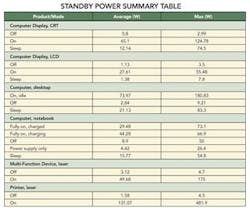Whenever an electronic device is plugged in, it adds to your building’s plug load, which increases energy consumption and, in turn, increases your energy bill. If you manage and reduce this load, you can cut your building’s energy consumption and boost the bottom line.
"Office plug loads account for about one-fifth of an office energy bill – roughly as much as heating, lighting, or air conditioning," says Ira Krepchin, associate director of research at E Source. "There are significant opportunities for energy managers to cut energy consumption, boost the bottom line, and trim corporate greenhouse-gas emissions through wise equipment procurement and effective practices."
In addition to lowering energy consumption from devices themselves, cutting the plug load can reduce air-conditioning loads. "Researchers at the Florida Solar Energy Center found that, for every 100-watt reduction in computer energy consumption in an office building, there’s a corresponding 28-watt drop in cooling loads," Krepchin says. "Because large offices are commonly charged higher rates during peak cooling hours, these midday HVAC savings can be especially lucrative."
Standby Isn’t Sufficient
As convenient as it is for a computer to go into standby mode and instantly respond when turned back on, it’s consuming energy all the time. "Any device that uses a remote control or microprocessors – including computers, printers, TVs, etc. – probably falls into this category," says Krepchin. "The phenomenon has been more widely studied for homes, but the DOE [says that it’s] about 5 percent of total electricity use in schools."
To eliminate standby plug loads, make sure equipment is completely turned off, which can be done via power strips. "Personnel can be assigned to turn off power strips during off hours; power strips can be connected to timers or occupancy sensors, and smart power strips with built-in occupancy sensors or activity sensors are available," Krepchin explains.
The Road to Reduction
"There are three ways to reduce plug loads," says Krepchin. "Setting up purchasing policies so that only the most efficient products are purchased; raising employee awareness about things like turning off equipment and establishing policies that prohibit certain kinds of equipment; and installing controls, such as occupancy sensors, that will turn things off when not in use."
Supplying power strips to employees to use for their often-forgotten energy users – such as computer speakers and radios – is a low-cost approach to reducing energy. Power strips are an easy way to quickly and easily shut off these devices at the end of the day, and can yield additional savings if also used with computers because they eliminate off-mode power draw.
Since computers are often the major load in office buildings, set aggressive power-management settings on all computer equipment. "Ensure that all office equipment (PCs, displays, copiers, etc.) have their power management – or ‘sleep’ settings – enabled," says Alan Meier, senior scientist in the Energy Analysis Department, Lawrence Berkeley National Laboratory. Also, back up disks during lunchtime so that all equipment can be switched off at night.
Although encouraging employees to set aggressive power-management settings on their computer equipment is essentially free and may result in greater awareness and less energy waste, there’s no way to ensure that employees will comply with the power-management policy. If this proves to be ineffective, Krepchin recommends using low-cost or free network-based power-management software. Unlike individual computer power settings, this software is centrally controlled, helping IT personnel ensure maximum energy savings, and making it less likely that users will disable it.
"A 2004 study by the Lawrence Berkeley National Laboratory revealed that 60 percent of office computers remain on overnight and during weekends, and only 6 percent use aggressive power-management settings," says Krepchin.
To determine your plug load, use a plug-in watt-meter to get the exact load or get an estimate by using a table of typical values, such as the one maintained by Lawrence Berkeley National Laboratory.
Kylie Wroblaski ([email protected]) is associate editor at Buildings.
